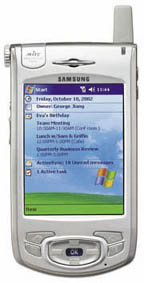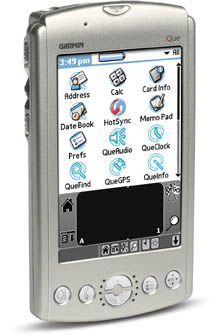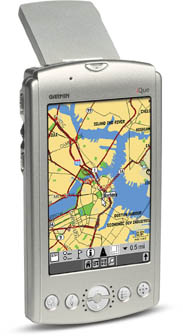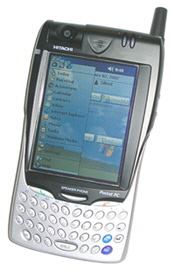January 2003
Palm's replacement of Graffiti
Here's the way we see it, folks: Palm's announcement basically means it will replace the Graffiti character recognition system with CIC's Jot technology that was based on Graffiti in the first place. Palm solely does so because of a longstanding Xerox law suit that claims an infringement of a patent on a unistroke alphabet (i.e. pen down, character, pen up). The Xerox unistroke alphabet looks nothing like the Graffiti characters. The annihilation of Graffiti over it, and Xerox's ridiculous claim that "we have several years of damages with this handwriting recognition system to address," are a travesty and just another example of how absurd lawsuits can mess things up for millions of consumers. -- Posted Tuesday, January 14, 2003
Samsung i700 Pocket PC debuts at CES
 There are a lot of cell phones with cameras coming out, and a few PDA phones that can work with cameras. But a cell phone PDA with a camera built in, now that's something new. Running Pocket PC 2002 Phone Edition, Samsung's new i700 was revealed last week. Samsung, who also showed two Palm OS phones, is also the first major hardware maker to license and produce products based on both major handheld operating systems. The swivel camera can capture 640 x 480 images which can be saved, sent to people via wireless connection, or synchronized with a PC. No pricing was given at press time. -- Posted Tuesday, January 14, 2003
There are a lot of cell phones with cameras coming out, and a few PDA phones that can work with cameras. But a cell phone PDA with a camera built in, now that's something new. Running Pocket PC 2002 Phone Edition, Samsung's new i700 was revealed last week. Samsung, who also showed two Palm OS phones, is also the first major hardware maker to license and produce products based on both major handheld operating systems. The swivel camera can capture 640 x 480 images which can be saved, sent to people via wireless connection, or synchronized with a PC. No pricing was given at press time. -- Posted Tuesday, January 14, 2003
Garmin introduces Palm OS GPS unit
 Garmin International introduced its iQue 3600 PDA with built-in GPS at the Consumer Electronics Show in Las Vegas last week. The new device uses Palm OS 5 and a 320 x 480 transflective TFT. Its virtual Graffiti area allows the device to display larger maps, because it can be moved out of the way. The first Palm OS device to use Motorola's new 150MHz DragonBall MXL ARM 9 processor, the iQue has 32MB RAM, high-fidelity audio, and an SD slot for expansion. Just like its name, the iQue includes Garmin's Que Technology, software that "delivers the benefits of GPS-based location awareness to PDA users in a friendly format," according to the company. A flip-up antenna provides GPS reception, best kept in the horizontal position; when flipped out, the GPS automatically turns on. The Palm's Date Book is then integrated into the system, allowing for navigation from where the user is to the address in question.
Garmin International introduced its iQue 3600 PDA with built-in GPS at the Consumer Electronics Show in Las Vegas last week. The new device uses Palm OS 5 and a 320 x 480 transflective TFT. Its virtual Graffiti area allows the device to display larger maps, because it can be moved out of the way. The first Palm OS device to use Motorola's new 150MHz DragonBall MXL ARM 9 processor, the iQue has 32MB RAM, high-fidelity audio, and an SD slot for expansion. Just like its name, the iQue includes Garmin's Que Technology, software that "delivers the benefits of GPS-based location awareness to PDA users in a friendly format," according to the company. A flip-up antenna provides GPS reception, best kept in the horizontal position; when flipped out, the GPS automatically turns on. The Palm's Date Book is then integrated into the system, allowing for navigation from where the user is to the address in question.

When using the MapSource CD-ROM, users can look up addresses to points of interest, like restaurants and gas stations, and get turn-by-turn directions from point A to B, with both audible and graphical cues. Dimensions are 5.0 x 2.8 x 0.8 inches, weight 5.2 ounces. There is a wire-mounted leather flip cover that flips up from the bottom to allow room for the antenna. This is also the first third-party device to use Palm's Universal connector, which hopefully means it will be compatible with existing Palm peripherals. Expected in the second quarter of 2003, the iQue 3600 will be priced at US$589. -- Posted Monday, January 13, 2003
Hitachi introduces Pocket PC Phone
 Hitachi introduced the Multimedia Communicator, based on the Pocket PC Phone Edition and supporting tri-band communication (CDMA, CDMA2000). The Hitachi uses a 400MHz XScale processor and has a built-in 640x480 digital camera and sort of looks like a hybrid between a conventional Pocket PC (top) and a RIM pager (bottom). The availability of a CDMA-based Pocket PC Phone is relevant because GSM still does not provide the same extensive coverage in the US. Also, the Hitachi's use of a XScale chip sets it apart from earlier Pocket PC phones which were still StrongARM-based.
Hitachi introduced the Multimedia Communicator, based on the Pocket PC Phone Edition and supporting tri-band communication (CDMA, CDMA2000). The Hitachi uses a 400MHz XScale processor and has a built-in 640x480 digital camera and sort of looks like a hybrid between a conventional Pocket PC (top) and a RIM pager (bottom). The availability of a CDMA-based Pocket PC Phone is relevant because GSM still does not provide the same extensive coverage in the US. Also, the Hitachi's use of a XScale chip sets it apart from earlier Pocket PC phones which were still StrongARM-based.
The Hitachi Multimedia Communicator is expected to be available in the summer from Sprint. -- Posted Friday, January 10, 2003
 There are a lot of cell phones with cameras coming out, and a few PDA phones that can work with cameras. But a cell phone PDA with a camera built in, now that's something new. Running Pocket PC 2002 Phone Edition, Samsung's new i700 was revealed last week. Samsung, who also showed two Palm OS phones, is also the first major hardware maker to license and produce products based on both major handheld operating systems. The swivel camera can capture 640 x 480 images which can be saved, sent to people via wireless connection, or synchronized with a PC. No pricing was given at press time. -- Posted Tuesday, January 14, 2003
There are a lot of cell phones with cameras coming out, and a few PDA phones that can work with cameras. But a cell phone PDA with a camera built in, now that's something new. Running Pocket PC 2002 Phone Edition, Samsung's new i700 was revealed last week. Samsung, who also showed two Palm OS phones, is also the first major hardware maker to license and produce products based on both major handheld operating systems. The swivel camera can capture 640 x 480 images which can be saved, sent to people via wireless connection, or synchronized with a PC. No pricing was given at press time. -- Posted Tuesday, January 14, 2003 Garmin International introduced its iQue 3600 PDA with built-in GPS at the Consumer Electronics Show in Las Vegas last week. The new device uses Palm OS 5 and a 320 x 480 transflective TFT. Its virtual Graffiti area allows the device to display larger maps, because it can be moved out of the way. The first Palm OS device to use Motorola's new 150MHz DragonBall MXL ARM 9 processor, the iQue has 32MB RAM, high-fidelity audio, and an SD slot for expansion. Just like its name, the iQue includes Garmin's Que Technology, software that "delivers the benefits of GPS-based location awareness to PDA users in a friendly format," according to the company. A flip-up antenna provides GPS reception, best kept in the horizontal position; when flipped out, the GPS automatically turns on. The Palm's Date Book is then integrated into the system, allowing for navigation from where the user is to the address in question.
Garmin International introduced its iQue 3600 PDA with built-in GPS at the Consumer Electronics Show in Las Vegas last week. The new device uses Palm OS 5 and a 320 x 480 transflective TFT. Its virtual Graffiti area allows the device to display larger maps, because it can be moved out of the way. The first Palm OS device to use Motorola's new 150MHz DragonBall MXL ARM 9 processor, the iQue has 32MB RAM, high-fidelity audio, and an SD slot for expansion. Just like its name, the iQue includes Garmin's Que Technology, software that "delivers the benefits of GPS-based location awareness to PDA users in a friendly format," according to the company. A flip-up antenna provides GPS reception, best kept in the horizontal position; when flipped out, the GPS automatically turns on. The Palm's Date Book is then integrated into the system, allowing for navigation from where the user is to the address in question. 
 Hitachi introduced the Multimedia Communicator, based on the Pocket PC Phone Edition and supporting tri-band communication (CDMA, CDMA2000). The Hitachi uses a 400MHz XScale processor and has a built-in 640x480 digital camera and sort of looks like a hybrid between a conventional Pocket PC (top) and a RIM pager (bottom). The availability of a CDMA-based Pocket PC Phone is relevant because GSM still does not provide the same extensive coverage in the US. Also, the Hitachi's use of a XScale chip sets it apart from earlier Pocket PC phones which were still StrongARM-based.
Hitachi introduced the Multimedia Communicator, based on the Pocket PC Phone Edition and supporting tri-band communication (CDMA, CDMA2000). The Hitachi uses a 400MHz XScale processor and has a built-in 640x480 digital camera and sort of looks like a hybrid between a conventional Pocket PC (top) and a RIM pager (bottom). The availability of a CDMA-based Pocket PC Phone is relevant because GSM still does not provide the same extensive coverage in the US. Also, the Hitachi's use of a XScale chip sets it apart from earlier Pocket PC phones which were still StrongARM-based.